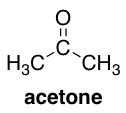 The majority of people know acetone only as it relates to removing nailpolish. Organic chemists like myself, on the other hand, would have a lot of trouble imagining life without acetone. At home, you wash your dishes with water, but in an organic chemistry lab, you wash your dishese.g., beakers, flasks, test tubes, etc. with acetone. A chemistry lab without acetone would be . . . well, very dirty.
The majority of people know acetone only as it relates to removing nailpolish. Organic chemists like myself, on the other hand, would have a lot of trouble imagining life without acetone. At home, you wash your dishes with water, but in an organic chemistry lab, you wash your dishese.g., beakers, flasks, test tubes, etc. with acetone. A chemistry lab without acetone would be . . . well, very dirty.
Thus, as a tribute to this tiny little molecule that works wonders on grimy glassware, the following are the top 10 things you did and/or didn’t know about acetone, in no particular order:
 (1) Traditional nail polish remover uses acetone as the main ingredient. Non-acetone nailpolish removers usually use ethyl acetate instead. Pros and cons? Acetone does a better job of prepping the nail for a new coat of paint (the polish will stay on longer), but ethyl acetate doesn’t dry out your nails quite as much.
(1) Traditional nail polish remover uses acetone as the main ingredient. Non-acetone nailpolish removers usually use ethyl acetate instead. Pros and cons? Acetone does a better job of prepping the nail for a new coat of paint (the polish will stay on longer), but ethyl acetate doesn’t dry out your nails quite as much.
(2) Acetone will remove more than just nailpolish – it’ll remove permanent marker too. So go ahead, write all over the windowsas long as there’s no coating, like tinting on car windows with a Sharpie. A little acetone will bring back that streak-free shine.
 (3) Don’t put acetone nailpolish remover in a styrofoam or plastic cup. It will dissolve the cup and you will have a mess to deal with.
(3) Don’t put acetone nailpolish remover in a styrofoam or plastic cup. It will dissolve the cup and you will have a mess to deal with.
(4) Acetone was the name of a band from southern California in the ’90s. They toured with The Verve for a while.
(5) Some people intentionally inhale acetone. This is bad for you. One Yahoo Answers writer imparts insightful advice for you if you have this addiction: “THROW-AWAY your acetone so that you cant inhale it any more.”
(6) Whereas most organic solvents, such as ethyl acetate, won’t mix with water (imagine trying to mix oil with water), acetone will.
(7) The smell of acetone on someone’s breath can be a very bad sign. This smell is associated with diabetic ketoacidosis, a life-threatening condition that can occur in diabetics who don’t get enough insulin.
(8) Acetone has been proposed as a fuel additive; the idea is that a small amount helps vaporize the gasoline, leading to better fuel efficiency.
(9) Most acetone is made during the production of phenol. Phenol is mostly used to make polymers like plastics; it was also the first antiseptic to be discovered, by Joseph Listeras in, Listerine.

 (10) During this year’s FIFA World Cup, a package was intercepted at an airport in Columbia that contained a replica of the World Cup trophy. Nothing inherently wrong with replicas, but this one was made out of 24 pounds of cocaine that had been mixed with acetone (or possibly gasoline, reports are unclear). Apparently if you mix cocaine with acetone you get a papier-mâché type goop that you can mold into whatever shape you want.
(10) During this year’s FIFA World Cup, a package was intercepted at an airport in Columbia that contained a replica of the World Cup trophy. Nothing inherently wrong with replicas, but this one was made out of 24 pounds of cocaine that had been mixed with acetone (or possibly gasoline, reports are unclear). Apparently if you mix cocaine with acetone you get a papier-mâché type goop that you can mold into whatever shape you want.


I once heard about a professor who was tired of losing acetone to other groups. He re-labeled his bottles “dimethyl ketone” and didn’t have a problem anymore.
i can has science ???!!
While acetone will remove Sharpie from clear glass, so will soapy water 😉 We label our casserole dishes and wine glasses with them at family gatherings- comes right off in the wash!